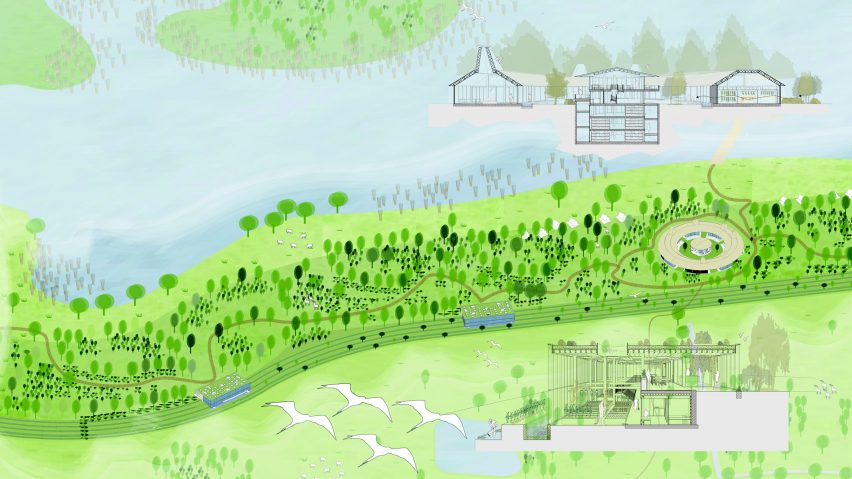
Fontys Hogescholen spotlights 10 student architecture and urbanism projects
Dezeen School Shows: a project that turns an industrial site into a nature reserve and a scheme for the adaptive reuse of towns are included in this school show by students at Fontys Hogescholen.
Also included is a rewilding system to bridge the gap between Dutch wildlife and agriculture and a three-part project focusing on the sustainable use of the Netherland's coastline.
Fontys Hogescholen
Institution: Fontys Hogescholen
Courses: Master of Architecture and Master of Urbanism
Tutors: Ad Kil, Pieter Feentra, Jan Willem van Kuilenburg, Leslie Kavanaugh, Iwan Westerveen, Jago van Bergen, Santiago del Hierro, Gert Kwekkeboom, Machiel Spaan, Ro Koster, Joep Klabbers, Alison Killing and Maurits de Hoog
School statement:
"The Fontys Master of Architecture and Urbanism offers a four-year concurrent masters programme, which allows students to combine their studies with employment in a professional environment.
"The academy is a laboratory, a playground for spatial assignments involving (real) stakeholders. The studio – alongside a theory and skills programme – forms the core of the programme, and is a perfect place to apply new design skills, methods and design proposals targeting contemporary complex spatial challenges.
"Students learn how to effectively combine design intelligence with a reflective attitude and practical skills in a small-scale academy where social commitment and future-thinking is at the centre.
"The curriculum is geared towards mastering seven crucial competencies: design, research, collaboration, communication, entrepreneurial skills, organisation and professional practice.
"Students can create their own path within the programme by choosing from a variety of topics that address contemporary urgencies such as inclusivity, digitalisation, climate change, urbanisation and more.
"During the last year (graduation) students focus on their own research-design project."
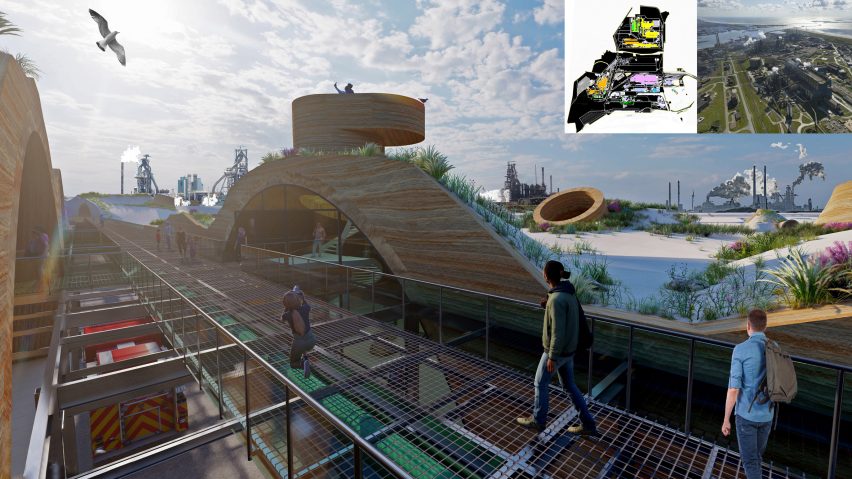
Campus Greensteel – design for a nature-inclusive Tata Steel industry by Bram van Vlijmen
"Campus Greensteel is the answer to the overhaul of the Tata Steel operations in IJmuiden, the Netherlands.
"The change to hydrogen power restores the site as a natural dune area by the combination of architectural and biological strategies.
"After clearing the coal depots and fossil fuel power plants, a network of hydrogen power units will take their place. The units are covered by cupolas and tunnels, constructed out of solidified sand.
"The open areas between the units become wetlands, and surrounded by new dunes, plant and animal life will find their habitats in these areas."
Student: Bram van Vlijmen
Course: Fourth Year – final graduation project
Tutors: Ad Kil, Pieter Feentra and Jan Willem van Kuilenburg
Email: postvoorbram[at]tele2.nl
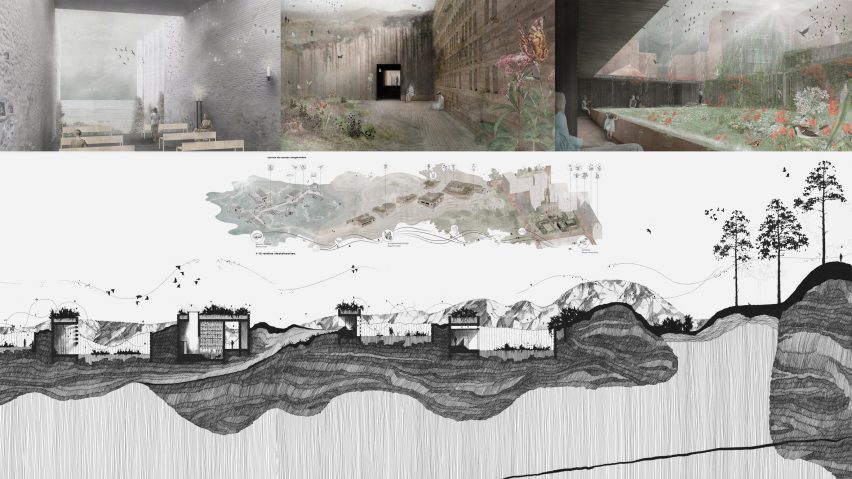
Ecofield – Shared Habitats by Joyce Verstijnen
"Ecofield is a new strategy to strengthen ecosystems in the Netherlands by means of architecture designed for the landscape, including animal and plant species.
"The current biodiversity policy Nature Network Netherlands – formerly Ecological Network – focuses on natural areas and thus ignores the potential contribution that the 'urban fabric' can make to Dutch biodiversity.
"Instead of separating town and country, Ecofield treats them as one ecological space.
"The strategy has been applied in the ecological space from Haarlem to the coast, which is marked by the city centre, dunes of the South Kennemerland, the North Sea, and five other landscape typologies.
"A recreational and contemplative walking route and eight areas of accommodation are included in the design, where people, plants and animals find shelter.
"When architecture is able to become part of this abiotic landscape, it will play a key role in the cohesion of ecosystems."
Student: Joyce Verstijnen
Course: Fourth Year – final graduation project
Tutors: Leslie Kavanaugh, Pieter Feentra and Jan Willem van Kuilenburg
Email: info[at]joyceverstijnen.nl
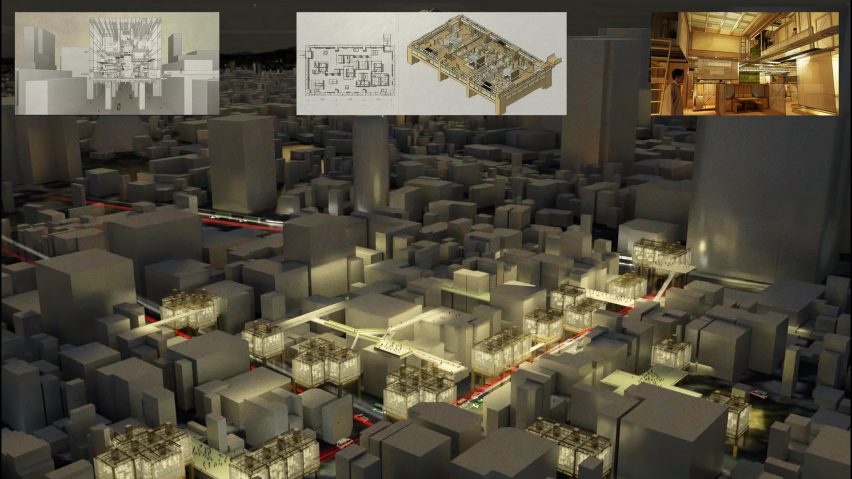
Architecture On Demand by Koen Huijs
"A theoretical and cultural framework, derived from Japanese sources and work by Lebbeus Woods, leads to a vision and design promoting neo-metabolism.
"De-territorialisation and translucency join in creating a collective environment with private units, assembled into a superstructure occupying the sky above the streets of Tokyo."
Student: Koen Huijs
Course: Fourth Year – final graduation project
Tutors: Iwan Westerveen, Pieter Feentra and Jan Willem van Kuilenburg
Email: koenhuijs[at]hotmail.com

Rewilding Architecture – a vision to wild farming communities by Matthijs Spijkers
"Rewilding is a new agrarian movement that welds together nature and farming. In this project, situated in the western part of the Zuiderwaterlinie, a new ecological landscape is created in a traditional agrarian area.
"Because of different subsoils a new zoning is introduced, including a lake with a floating farming village and an extended earth body with forest and plantations.
"A former tip is reforested and becomes a site for a sky village.
"Extensive research is conducted to establish the right ecological balance between natural crops and the establishment of a local community with enough turnover to trade with others.
"The design of farm facilities and housing follows a line similar to the architecture of the landscape: living quarters and social places are integrated in the production or processing facilities.
"This directness delivers a functional, abstract architecture, with equal attention for plants, humans and animal life."
Student: Matthijs Spijkers
Course: Fourth Year – final graduation project
Tutors: Jago van Bergen, Pieter Feentra and Jan Willem van Kuilenburg
Email: matthijsspijkers[at]gmail.com
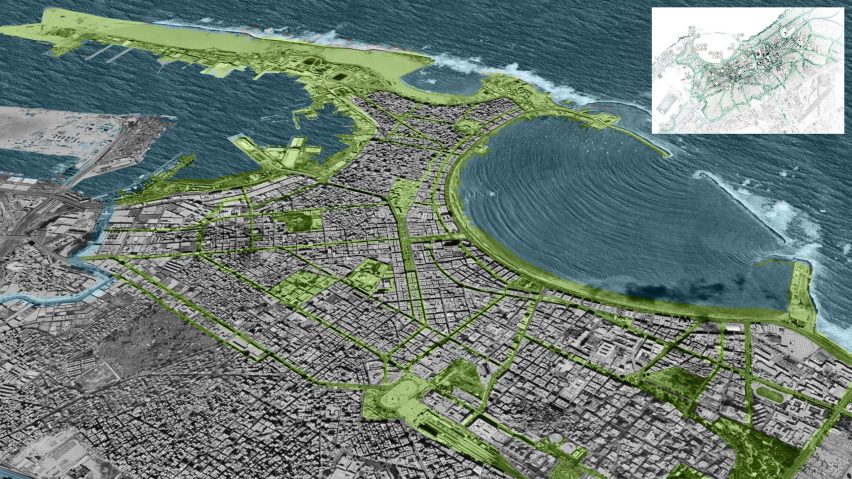
The Rebirth of Paradise by Mohamed Hassan Morsi
"Urban planning for climate change is a complex topic for large, historic cities like Alexandria, which are also coping with economic and demographic pressures.
"In this project the design of water engineering is drawn into the horizon of the local population by mapping several containment measures in relation to each other, and in relation to the larger whole of the urban area and to its distinctive districts in the centre.
"The waterfront along the central bay will not be safeguarded by a single wall like in the current situation, but by a layered dike system.
"The districts in the city operate with reservoirs and water systems, giving rise to the greening of the city and the redesign of public squares and roads.
"The districts along the southern canal, guiding the water from the Nile delta, will offer more space for green developments for holding and detaining water."
Student: Mohamed Hassan Morsi
Course: Fourth Year – final graduation project
Tutors: Santiago del Hierro, Pieter Feentra and Jan Willem van Kuilenburg
Email: mohamed.e.morsi[at]gmail.com
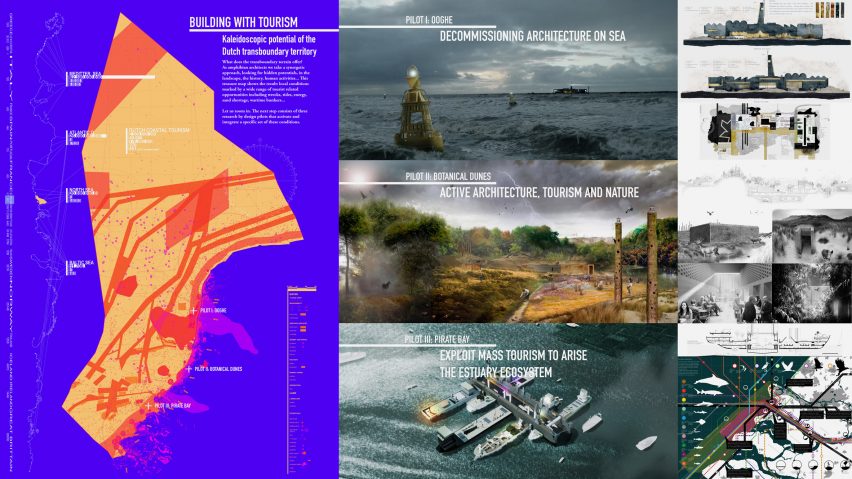
The Foreshore project by Nicky Kouwenberg, Niek van de Calseijde and Sidney van Wel
"The Foreshore project is dedicated to generating new coastal tourism and includes three student projects.
"Botanical Dunes aims to halt the destruction of the dunescape in the Zuid-Kennemerland National Park. The project explores how the landscape, nature and humanity can strengthen each other and develop together.
"Ooghe 52 degrees is a response to Dutch coastal development and presents a new sea-based intervention based in the North Sea. It reintroduces an Ooghe – an underwater mudflat where a refinery is placed. This development creates new experiences for the landscape and tourism opportunities.
"Pirate Bay aims to enhance both tourism activities and nature in the estuary of the Haringvliet. A tourist resort made from old scrapyard shipping facilities is assembled into a productive machine that aims to enhance the natural environment.
"Waste from tourists will be re-used in different development strategies. It will be used for algae production and therefore biofuel. The seaweed farming process will be a year-round activity in the dock for new eco farmers."
Students: Nicky Kouwenberg, Niek van de Calseijde and Sidney van Wel
Course: Fourth Year – final graduation project
Tutors: Gert Kwekkeboom, Machiel Spaan, Ad Kil, Ro Koster, Pieter Feentra and Jan Willem van Kuilenburg
Emails: nicky[at]nbarchitecten.nl, n.vandecalseijde[at]outlook.com and sidneyvanwell[at]home.nl
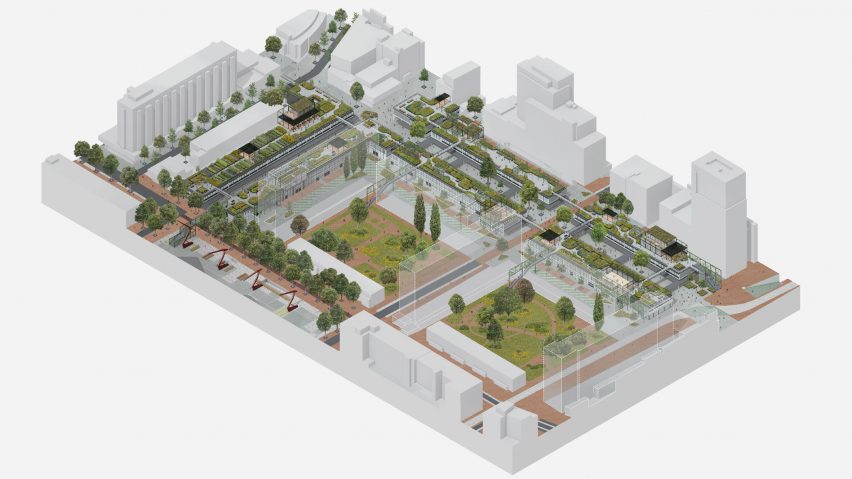
Between The Layers – Lijnbaanpark Rotterdam by Paul Bernards
"Lijnbaanpark improves the environmental quality of the Lijnbaan district in Rotterdam by introducing green rooftop architecture and skywalks, which the aim of developing a pedestrian circulation network above the streets in the city.
"The Lijnbaan is an icon of modern architecture, and although it has undergone several changes over years, the historic importance still calls for attention to the principles of its original urban and architectural design.
"The design remains close to the original structure, yet also offers possibilities for a dynamic transformation in the years to come, albeit in a modest tone.
"The accompanying studies make clear that recent adaptations in the facades and shopping requirements restrict the original variety and adaptivity of the design of the Lijnbaan.
"A more diverse use of the environment could divert this trend and might evolve into a newly balanced architecture for the city."
Student: Paul Bernards
Course: Fourth Year – final graduation project
Tutors: Joep Klabbers, Pieter Feenstra and Jan Willem van Kuilenburg
Email: paul.bernards[at]hotmail.com
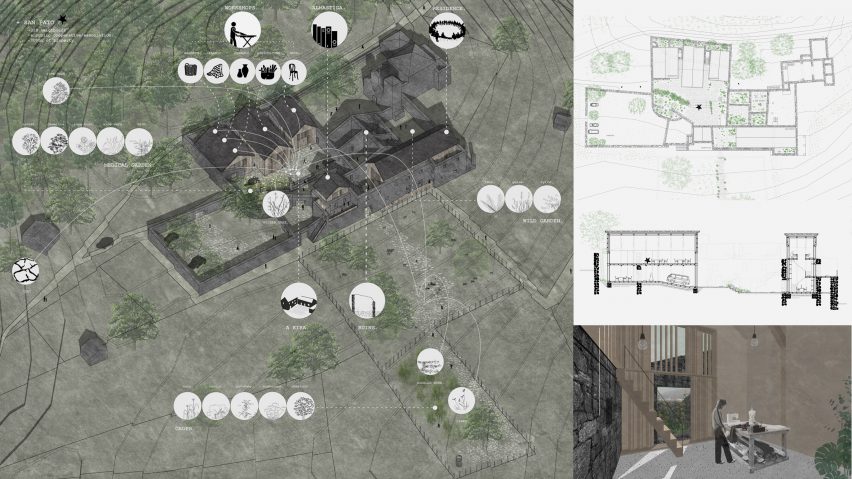
From the Rural Ashes by Paula Cores Barral
"Abandoned villages and ruins are the consequence of depopulation. The region of A Ribeira Sacra in Galicia, Spain, is an example of this – since 1981 the region has lost 40 per cent of the population.
"A sustainable masterplan will bring a future to such areas by repurposing ruins and reactivating rural areas.
"Restoring the ruins will be the visible key elements of a strategy that will settle a community, open business possibilities, allowing people to return, settle and establishing a new relation with the heritage, culture and nature.
"This intervention could be the prototype for other abandoned villages around the world."
Student: Paula Cores Barral
Course: Fourth Year – final graduation project
Tutors: Alison Killing, Pieter Feenstra and Jan Willem van Kuilenburg
Email: paula.cores.barral[at]gmail.com
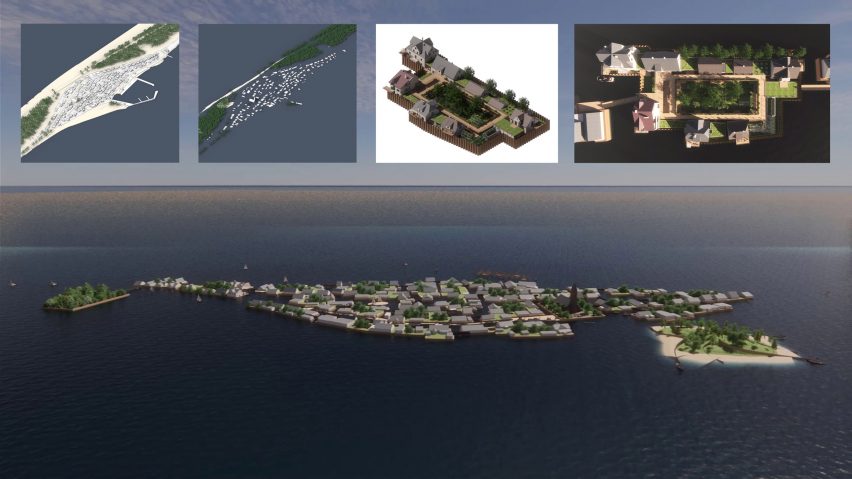
Kusfeld – Gardens in the Sea by Piotr Kalbarczyk
"Hel Peninsula, a 34-kilometre-long narrow strip of land off the Polish coastline, is an artistry of nature that until the 18th century was an archipelago of islands.
"The project aims to protect this touristic paradise from rising sea levels.
"Through architectural design, a looming dark future is transformed into a promising, attractive and sustainable settlement with unique land-water-life qualities."
Student: Piotr Kalbarczyk
Course: Fourth Year – final graduation project
Tutors: d Kil, Pieter Feenstra and Jan Willem van Kuilenburg
Email: piotr.kalbarczyk[at]yahoo.com
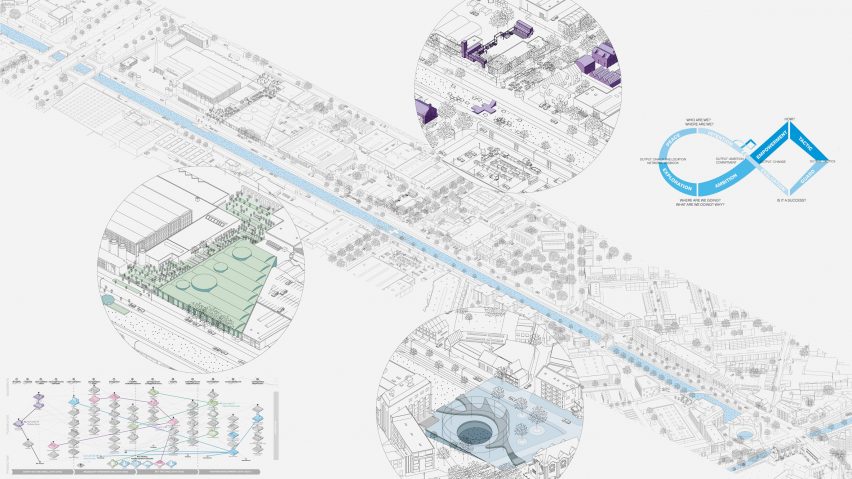
Blue Corridor City Lab – open city innovation by Tom van Tuijn
"Blue Corridor City Lab is a mixed and healthy urban area where people work and live, and where culture unfolds.
"At the same time, it is a sustainable area where supply and demand are closely related, where development is made possible by a do-it-yourself mentality.
"Ready for the 21st century, the 'Blue Corridor' acts as a connector along the Eindhoven Canal between city and rural areas, and is made by local initiatives combined with a few strategic investments.
Student: Tom van Tuijn
Course: Fourth Year – final graduation project
Tutors: Maurits de Hoog, Pieter Feenstra and Jan Willem van Kuilenburg
Email: tomvantuijn[at]gmail.com
Partnership content
This school show is a partnership between Dezeen and the Fontys Hogescholen. Find out more about Dezeen partnership content here.